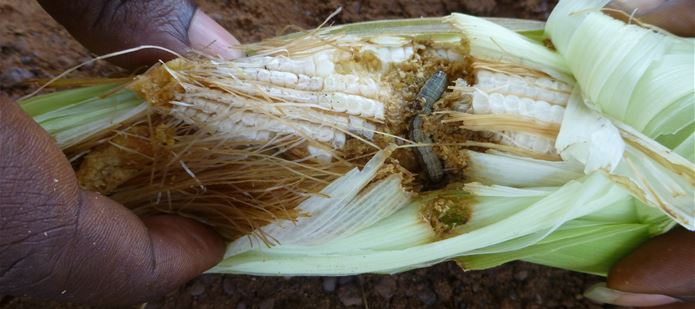
By Atayi Babs
Farmers across Africa are reeling under huge losses linked to the devastation by an invasive specie called Fall army worm, also known as Spodoptera frugiperda.
With origins in Eastern, and Central North America and in South America, the caterpillar has since 2016, found its way into 44 African countries, causing significant damage to maize crops with great potential for further spread and economic damage.
In sub-Saharan Africa, fall army worm has instigated heavy losses to staple cereals, especially maize and sorghum, affecting food security and trade, thus upsetting the continent’s plan to feed itself.
The extent of the destructive influence the invasive pest wrecks on maize alone is estimated to be between USD$ 2.5 – 6.2 billion per year, destabilising the livelihoods of around 300 million people.
This and many more reasons spurred experts attending the 2018 African Green Revolution Forum (AGRF2018) which began today in Kigali, Rwanda, to deliberate and explore ways of preventing or mitigating the next outbreak in Africa.
Setting the scene at a session on building the resilience of Africa’s agriculture against invasive species, Dr. Dennis Rangi, Director General of the Centre for Agriculture and Biosciences International (CABI) identified continuing globalisation through increasing trade, travel, and transport of goods across borders as one of the factors facilitating the spread of invasive species, with increasing negative impacts.
The problem, according to him, “is global in scope and requires international cooperation to supplement the actions of governments; the private sector and organisations at national and local levels.”
The recent arrival of fall armyworm in India is a case in point. The caterpillar’s leap from Africa to India confirms the global nature of invasive species and the need for partnerships to tackle the pest.
According to Dr Rangi, “a straightforward, three-pronged, internationally recognised approach to addressing the problem of invasive species, namely prevention, early detection & rapid response, and lastly control will help a great deal.”
However, transforming this approach into a reality in policy and practice remains a huge challenge in Africa as African famers usually find themselves trying to address the latest invasion, when the previous invasion is yet to be cleared.
They also lack adequate information and knowledge about preventing and detecting an invasion early enough.
To overcome these challenges, the CABI DG urged African countries to create a policy and regulatory environment that promote sustainable approaches in tackling invasive species; put in place a national invasive species strategy and action plan; and a sustainable investment plan.
Dr. May-Guri Saethre, Deputy Director General, Research for Development at International Institute for Tropical Agriculture (IITA) bemoaned the fact that the burden of handling and combating invasive species on a day-to-day manner is to a large extent left to the individual smallholders in Africa.
The way forward, according to her, lies in “working together, farmers, government, researchers and the private sector as current outbreaks are wake-up calls for firm action to protect Africa’s agriculture from the destructive impact of pest outbreaks.”
To prevent the next outbreak, technologies capable of stopping pest and disease entry into Africa by pre-emptive biological controls, horizon scanning and effective early warning systems are available and must be deployed to prevent establishment of new pest through coordinated response and eradication programmes,” Dr Saethre added.
Chief Scientist at the USAID Bureau for Food Security, Dr. Rob Bertram sees it differently. To him, fall armyworm is a reminder that we leave in a small world that is increasingly becoming smaller and we are more connected than ever. The answer therefore, “is more global connectedness through south-south and north-south learning; research networks; national level leadership; and a coherent regional approach to invasive species,” Dr. Bertram said.
In all, the experts were of the view that tackling fall armyworm in Africa requires a cocktail of solutions which include enabling policy environment, science and evidence-based framework, research and development that encourages private sector investment, local knowledge sharing, information dissemination and surveillance.
The forum also agreed substantially with the Director General of the Rwandan Agriculture Board, Dr Dennis Kyetere in his assertion that for Africa to feed itself, “agriculture must now be knowledge-intensive and technology-intensive.”
Indeed, the the presence of fall armyworm in Africa is both a crisis and an opportunity as a crisis is a terrible thing to waste – will Africa seize the opportunity?












